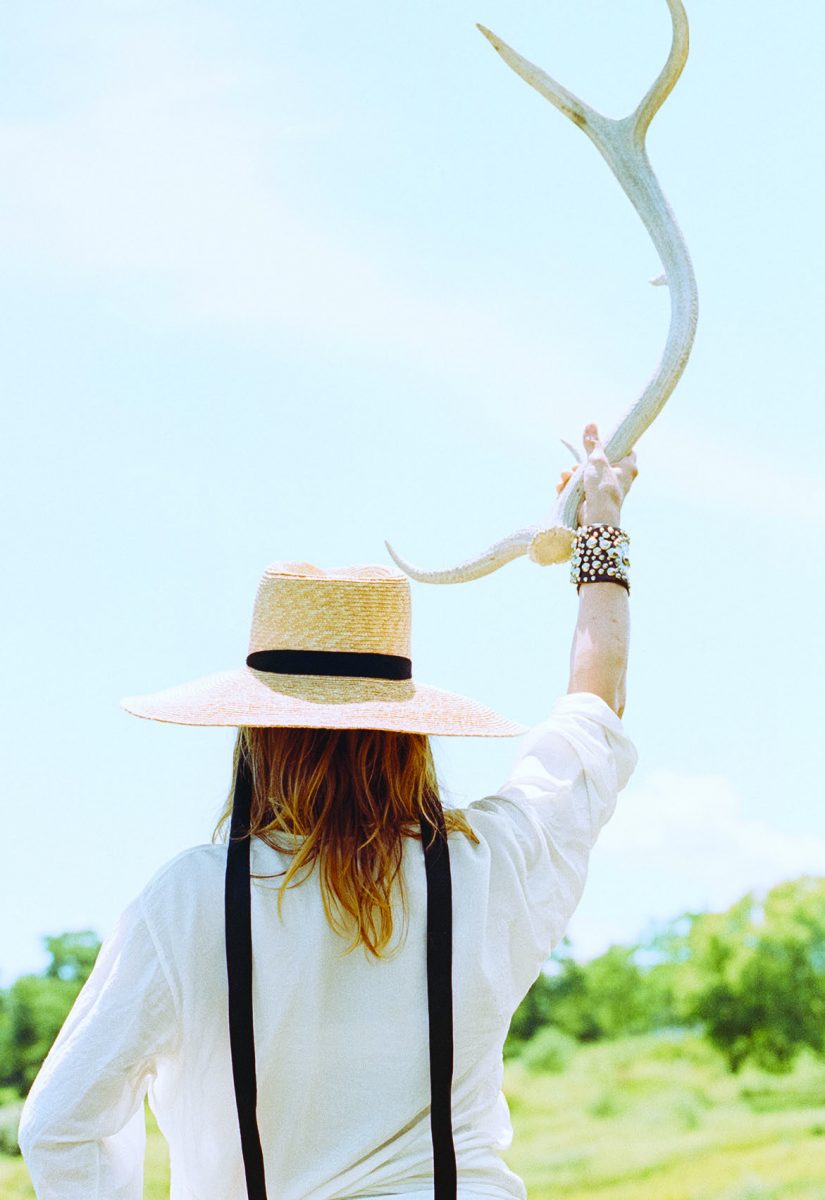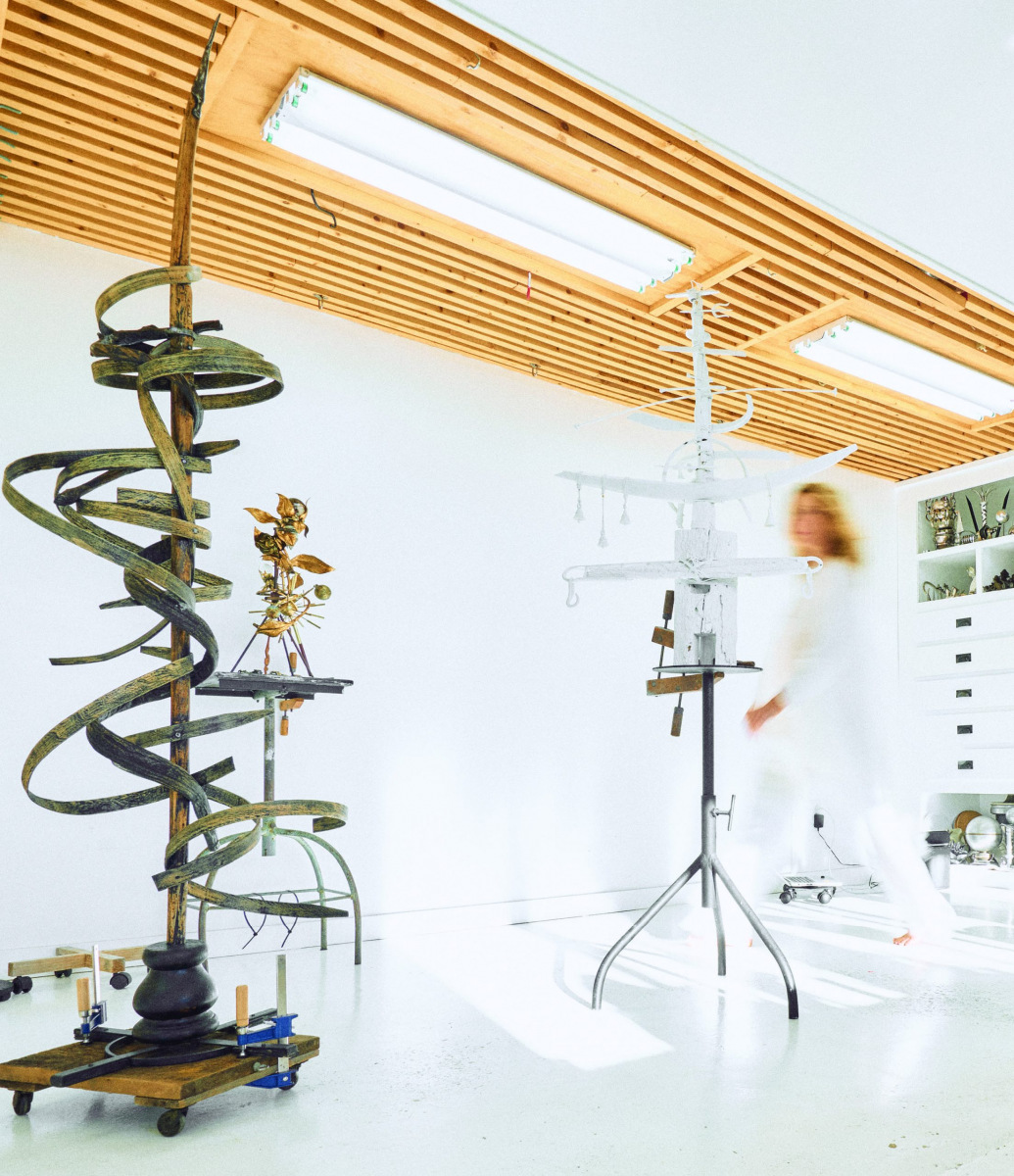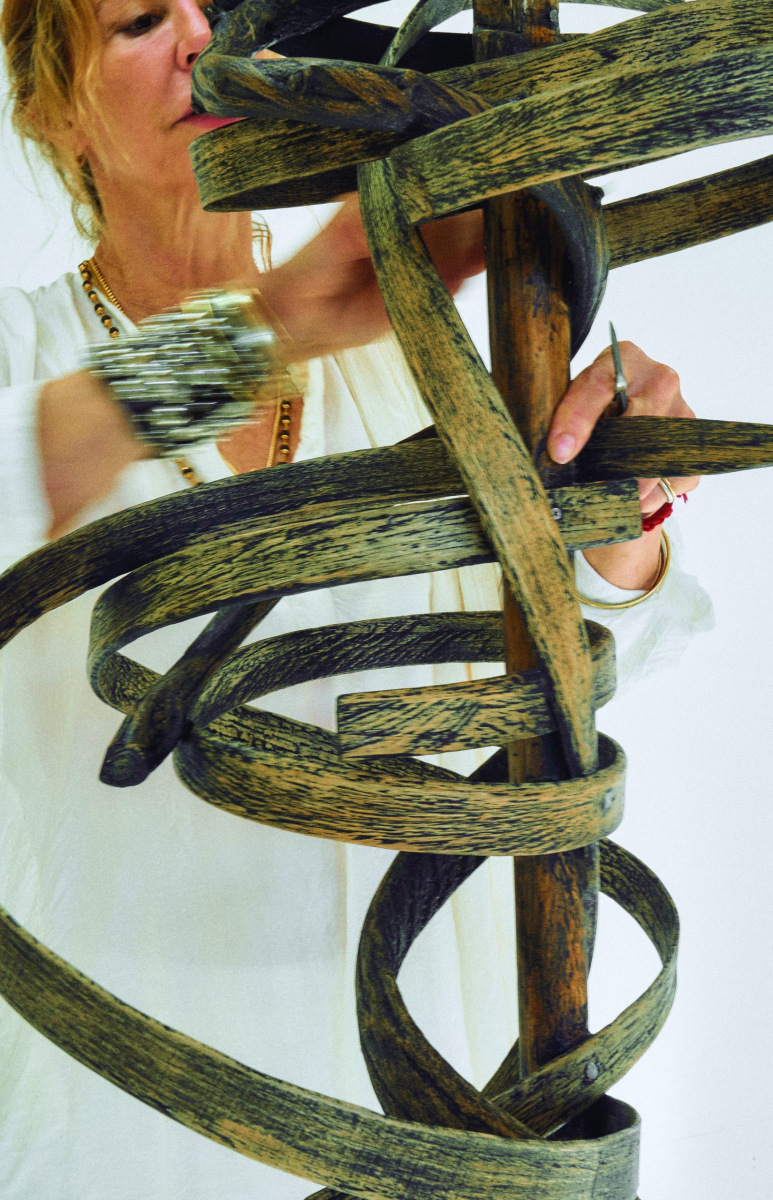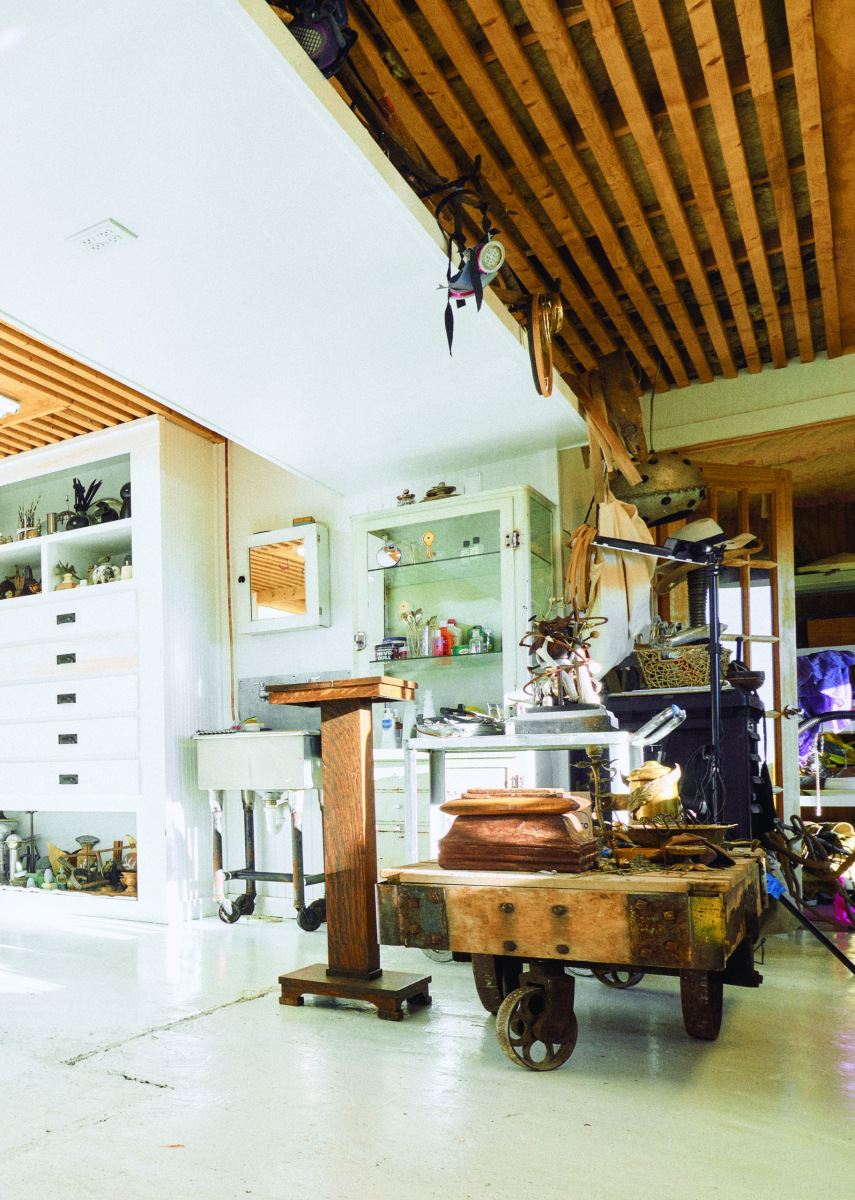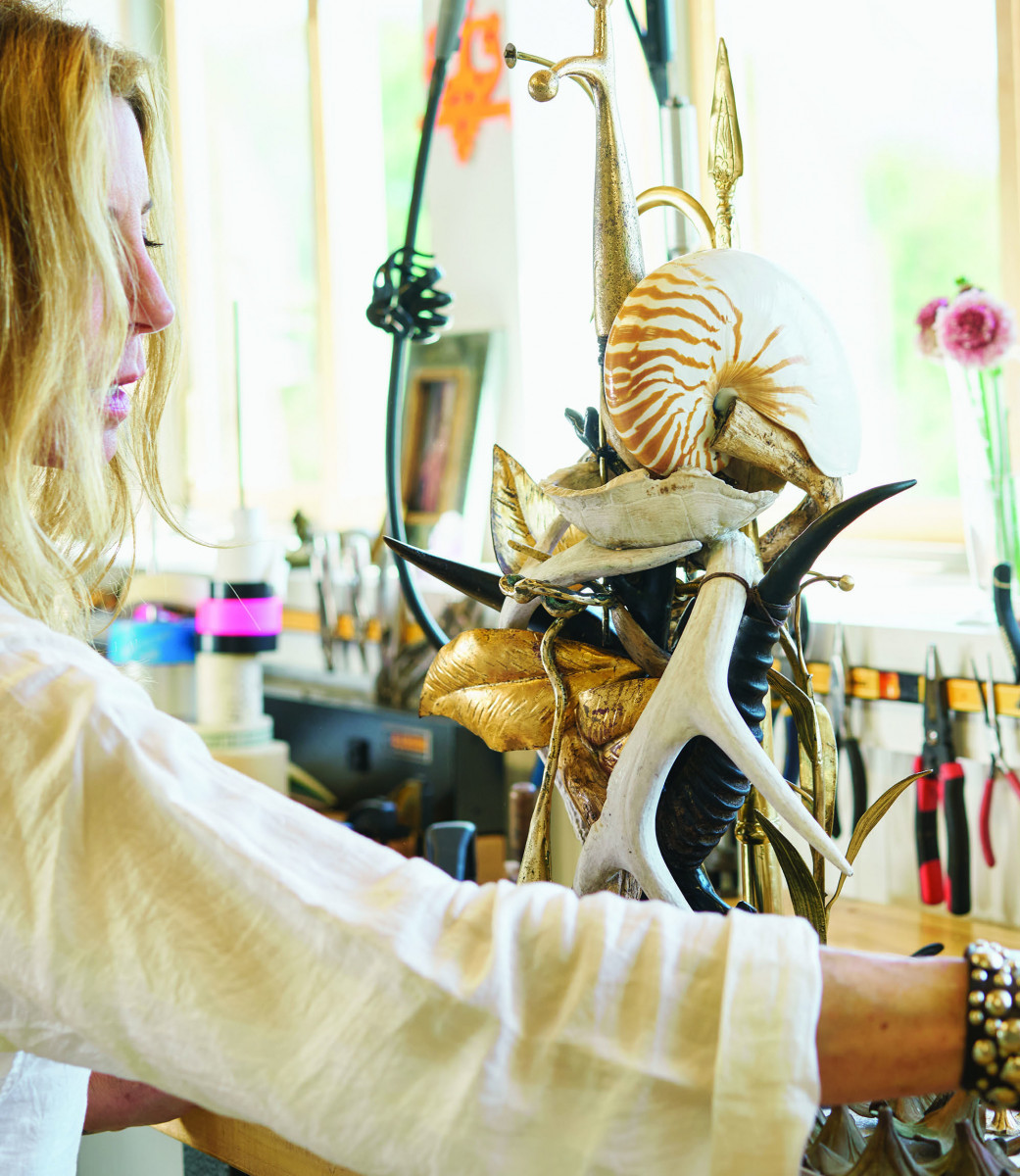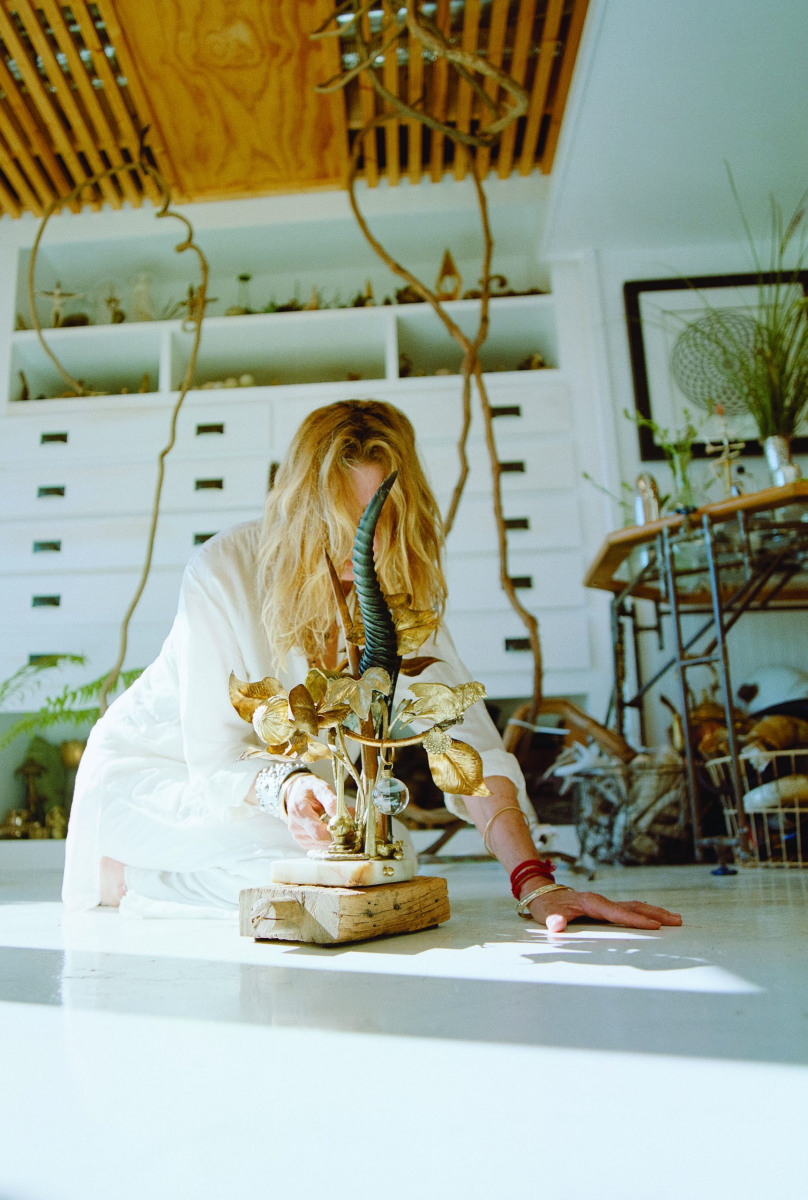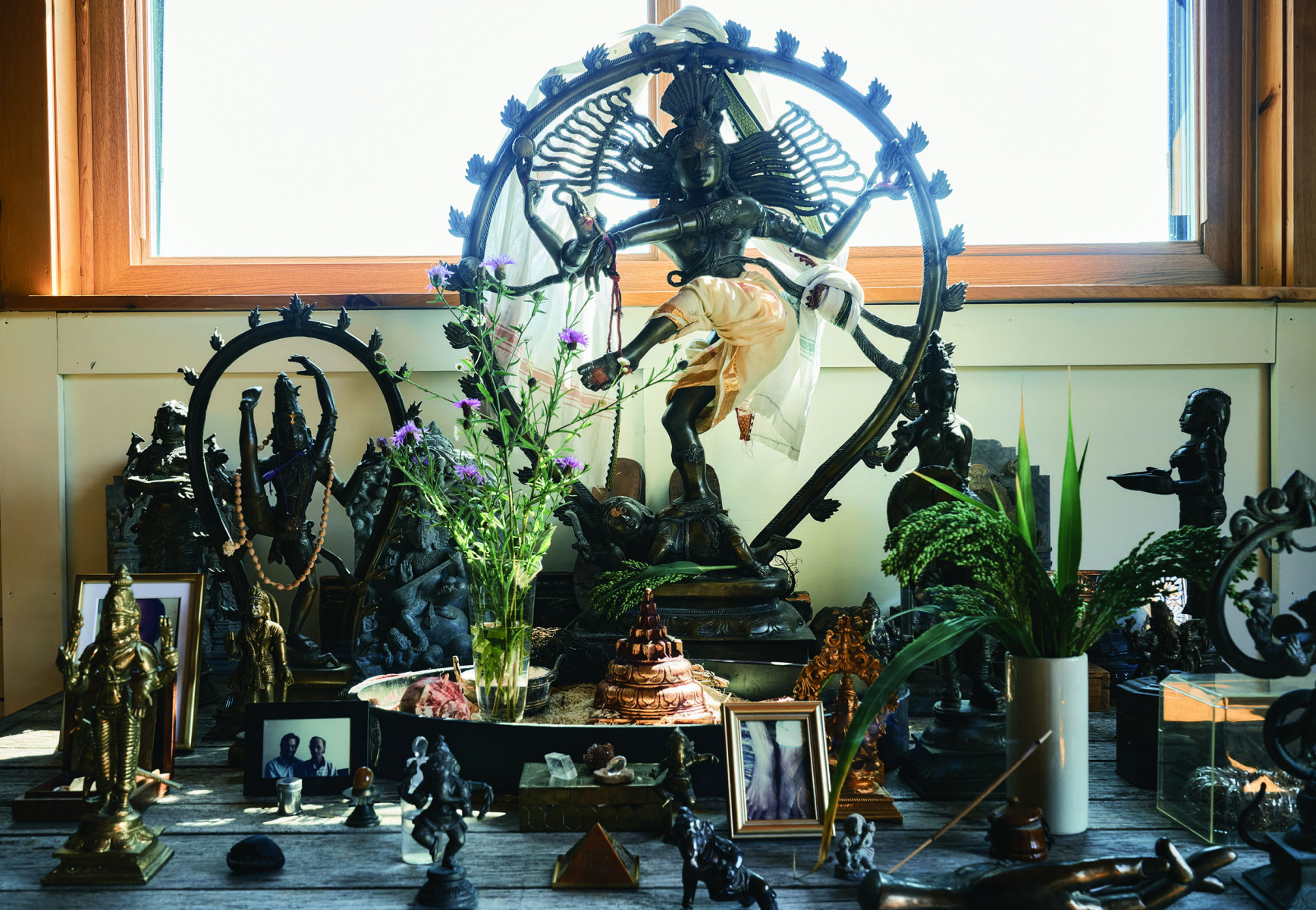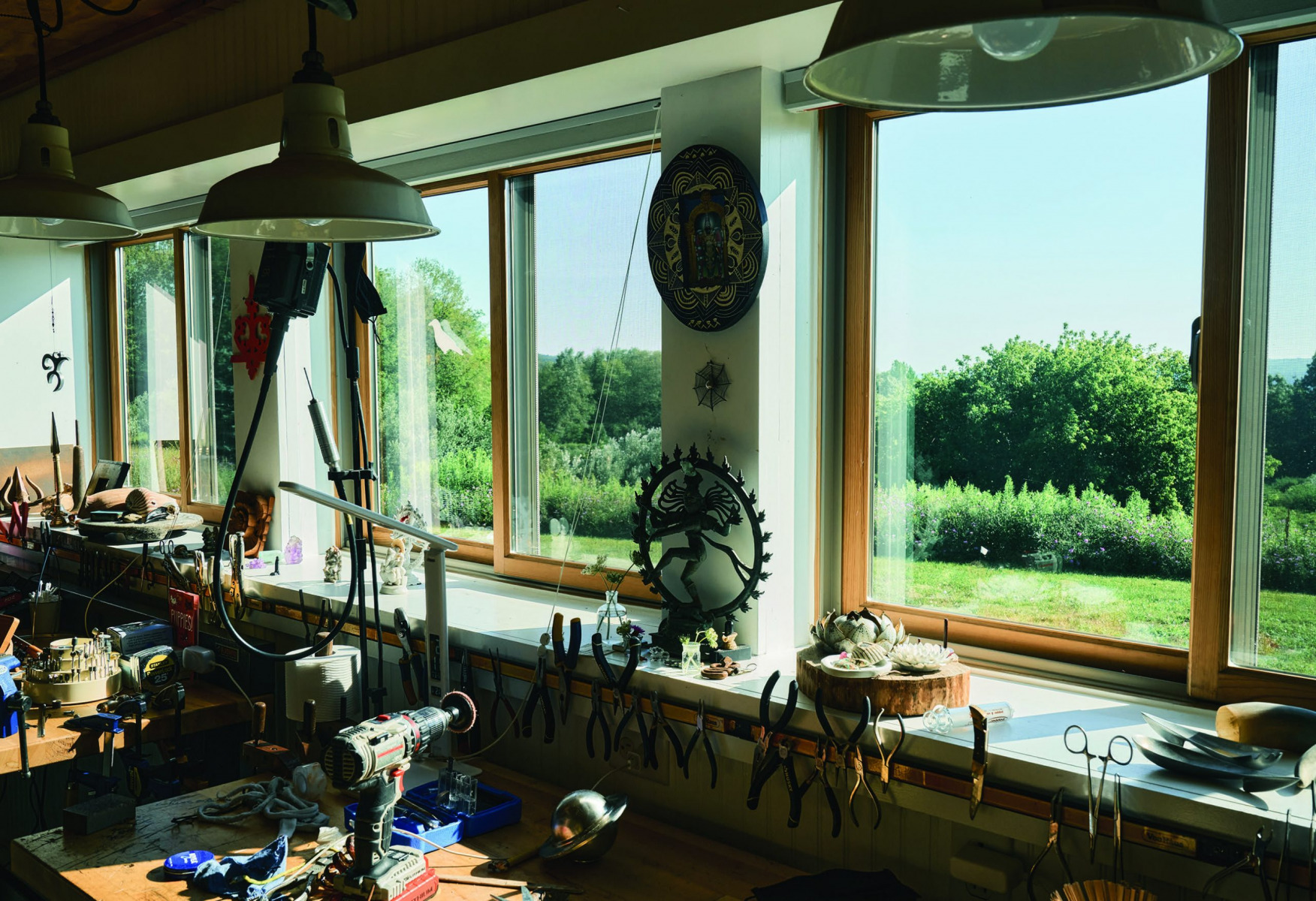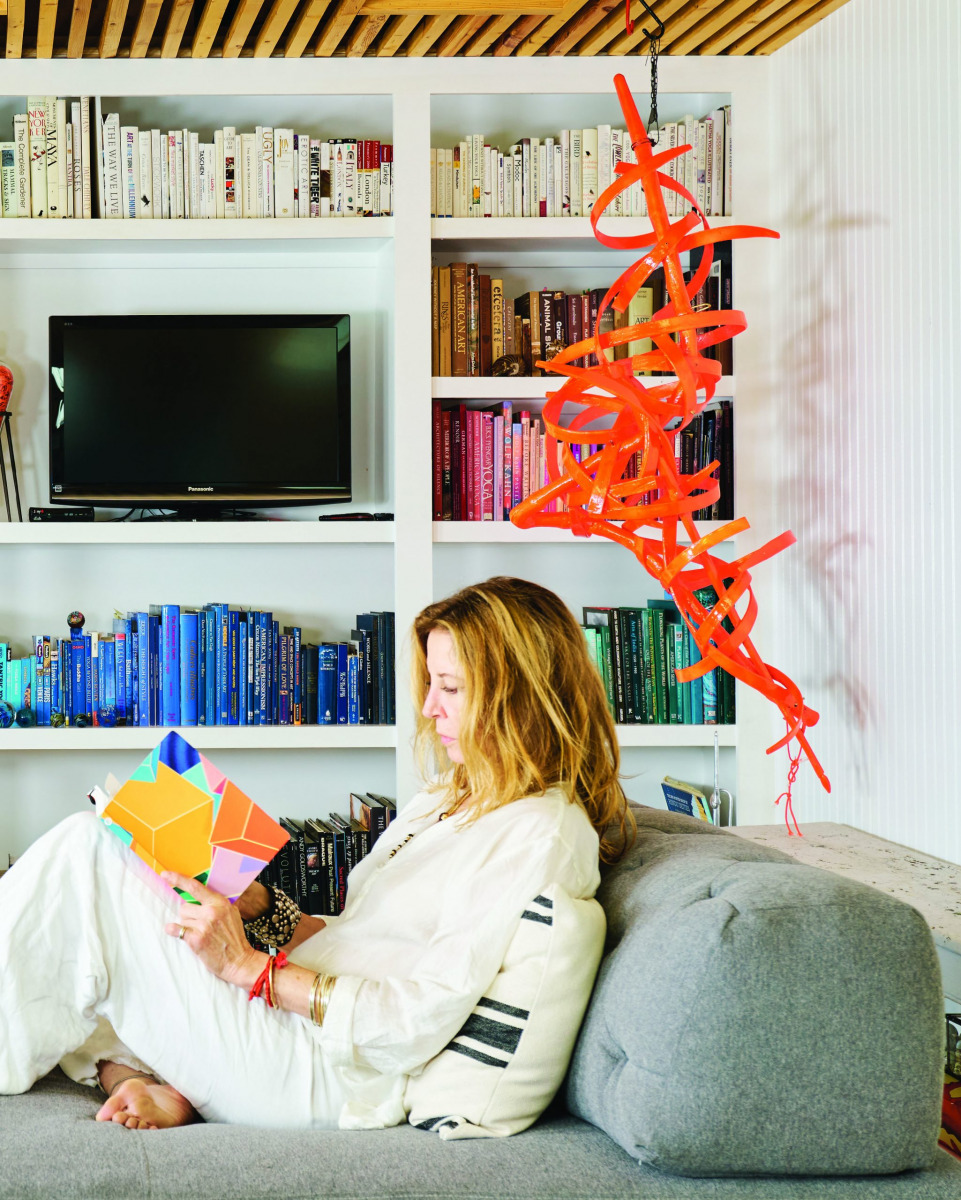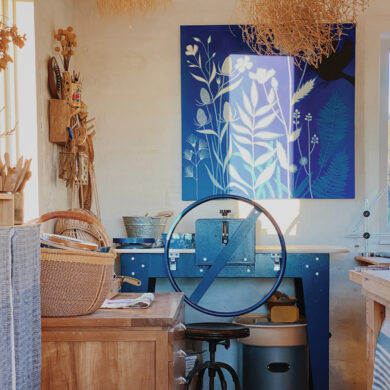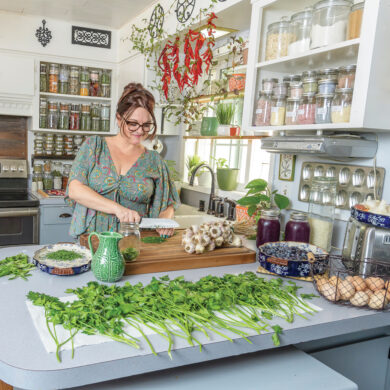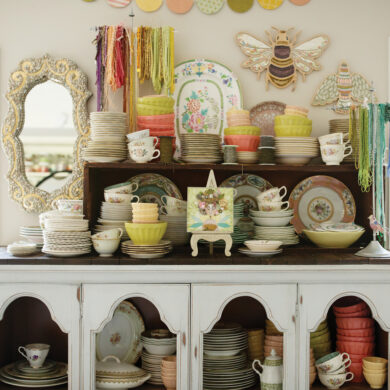About six years ago my husband and I started watching the series Vikings. In the show’s first few moments I saw something in the character Loki’s lair that changed the direction of my work. Hanging from a tree was a talisman made of driftwood or delicate animal bones. It reminded me of an ancient cairn and appeared to be quite important: it was telling a story or was part of the story being told. This was a defining moment for me, a true epiphany.
I realized at once the purpose of my obsessive collecting, that the multitude of archived objects I’d been squirreling away my entire life were an extension of myself. I choose them because they choose me.
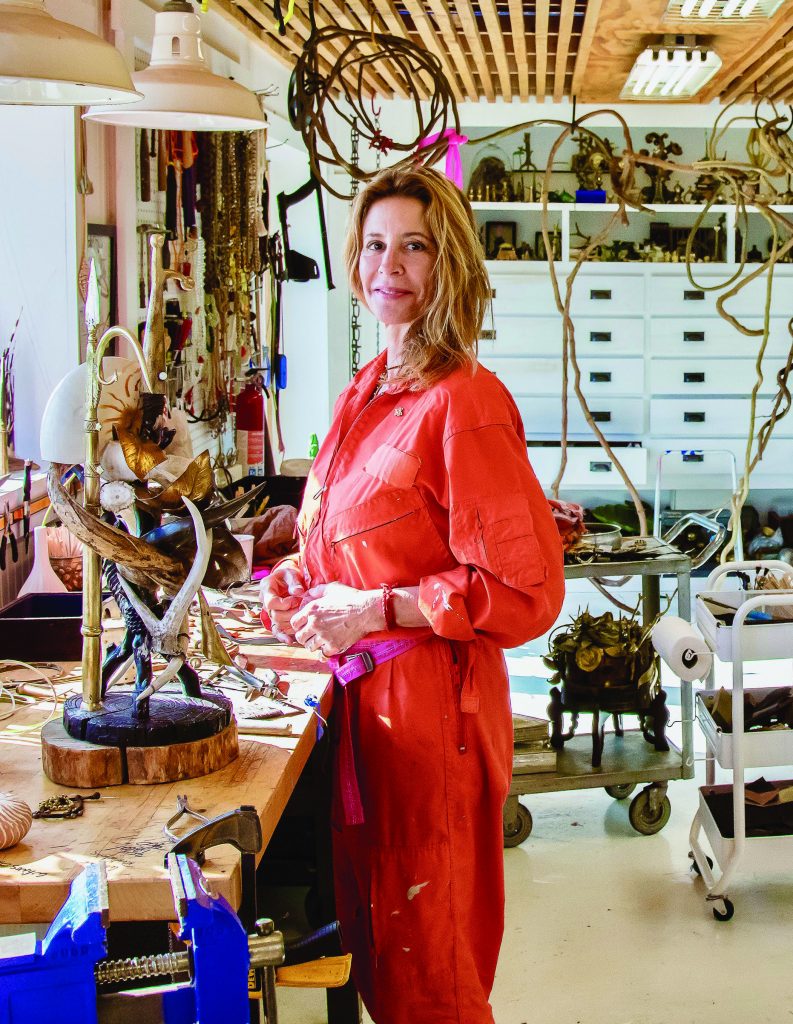
I knew I would have to work with the possibilities and limitations that are part of our home environment but also that my collecting, organizing the droves of objects, accessing them and working in the studio were all vital aspects of the sculptures I was envisioning. My inventory has grown by matrices over the years and will continue to grow, but their place in an intuitively redesigned, reimagined studio would allow me to evolve and grow, all as parts of myself. I envision three-dimensional sculptures that are both evocative and narrative, that express my feelings directly and also tell the stories that have shaped my life’s experience and my imagination.
Like the organs in the body, I know where every new piece naturally and intuitively needs to go. My organic sensibility about my inventory became an important part of transforming a new studio. I needed to find a place for all like-minded things to live together.
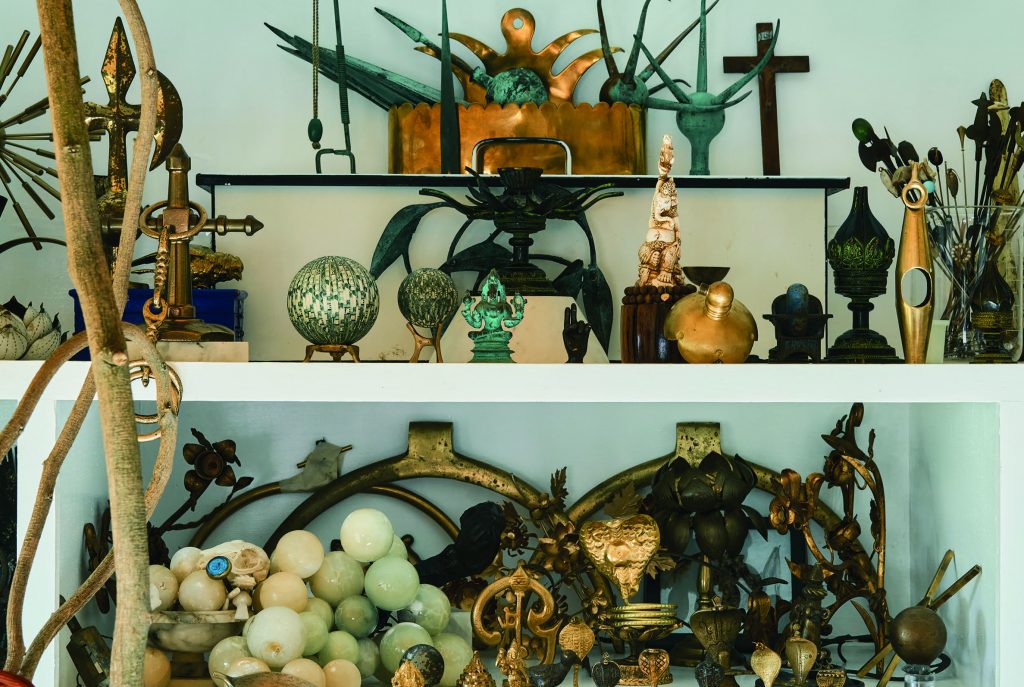 This awakening to make sculpture was all the more strange because I’d been principally a painter ever since I was a child. I graduated from the Philadelphia College of Art in 1980 with a BFA in Painting, and like many artists, I had to stop painting in order to support myself—working in restaurants, of course. I had landed a few rewarding jobs after college, including owning a yoga and Pilates studio in New Hope, PA. Years of studies in the mythology of the Hindu gods and goddesses had proven an essential element in teaching asana (yoga poses) and has deeply informed my three-dimensional work.
This awakening to make sculpture was all the more strange because I’d been principally a painter ever since I was a child. I graduated from the Philadelphia College of Art in 1980 with a BFA in Painting, and like many artists, I had to stop painting in order to support myself—working in restaurants, of course. I had landed a few rewarding jobs after college, including owning a yoga and Pilates studio in New Hope, PA. Years of studies in the mythology of the Hindu gods and goddesses had proven an essential element in teaching asana (yoga poses) and has deeply informed my three-dimensional work.
My family has deep personal connections to India that began even before meeting my husband, a professor of Hinduism and comparative religions. These stories have always been important to my evolution as an artist. We’ve since made numerous pilgrimages all across India, which has given me a much broader scope in understanding the pantheon of Hindu deities. I work in tandem with these images, symbols, and stories. All of my sculptures start with a narrative; there is always a thread of recognition I am pointing towards. My hope for the individual viewer is to formulate their own personal interpretation.
After the epiphany triggered by Vikings I also began to explore more seriously Norse and Celtic traditions. I became fascinated with representations of cosmology, such as helixes, DNA, and spirals, which led to studies in astronomy and physics and the sixteenth century’s mechanical representations (think: Galileo Galilei) inspired as much by religion as imagination. I began to see the gods and goddesses of all the pantheons anew. I was reimagining worlds of myth and science, and the feelings that emerged from these studies.
Also evolving was a deeper connection with my lifetime of exploring forests, deserts, creek beds, beaches, and ravines. I realized a pattern: objects, particularly antlers, bones, and fossils, seemed to find me. I could feel their presence, see the temperature of the color they emit. My first significant find was a lost child’s tea set in the snow and then, in that same forest in New Hope, PA, I saw the top of a skull and then bones, both unfamiliar to me, peeking out of the snow. It turned out to be a male black bear. Going back to the site many times over, I collected most of the bear’s bones and reassembled him on my dining room table. I began studying the anatomy of the forest animals in my area, identifying their tracks, feathers and fur, bones and scat. From that point forward, journeys anyplace meant that I would be bringing home countless objects, including things that humans had left behind or lost.
 When all of this excavation and collecting began 60 years ago, I hadn’t the slightest idea what I would do with all I was finding. I only knew that I had to keep doing it. I knew it was important for the journey to continue and that at some point I would discover why. The journey itself would reveal its purpose. Everything was connected—being a lifelong artist, a seeker, a finder of objects, a lover of myth and science.
When all of this excavation and collecting began 60 years ago, I hadn’t the slightest idea what I would do with all I was finding. I only knew that I had to keep doing it. I knew it was important for the journey to continue and that at some point I would discover why. The journey itself would reveal its purpose. Everything was connected—being a lifelong artist, a seeker, a finder of objects, a lover of myth and science.
We live on some 50 acres in the Finger Lakes region of western New York with (very) long winters, extreme, dramatic weather, which is often harsh and rarely just calm. There is a wildness here, a sense of being out of control, and yet life organizes itself and is always moving.
In our area I find many farmers’ dumps and the detritus of centuries past. As I enter these places I surrender to the possibilities of what might be in the earth waiting for liberation. Each time I go exploring I learn more about where treasures are likely to be and how to see them, but the process of looking and finding has always felt mutual. What I find finds me, on the outside and inside.
Because everything has a story, I was looking to tell my own.
In my studio things, too, can get wild; it may look chaotic or disorganized but then the pieces come together—even when the center cannot hold—and the objects form into the stories I want to tell. The sculptures tell those stories by being made of my entire journey of experiences. Their meaning is up to the viewers.
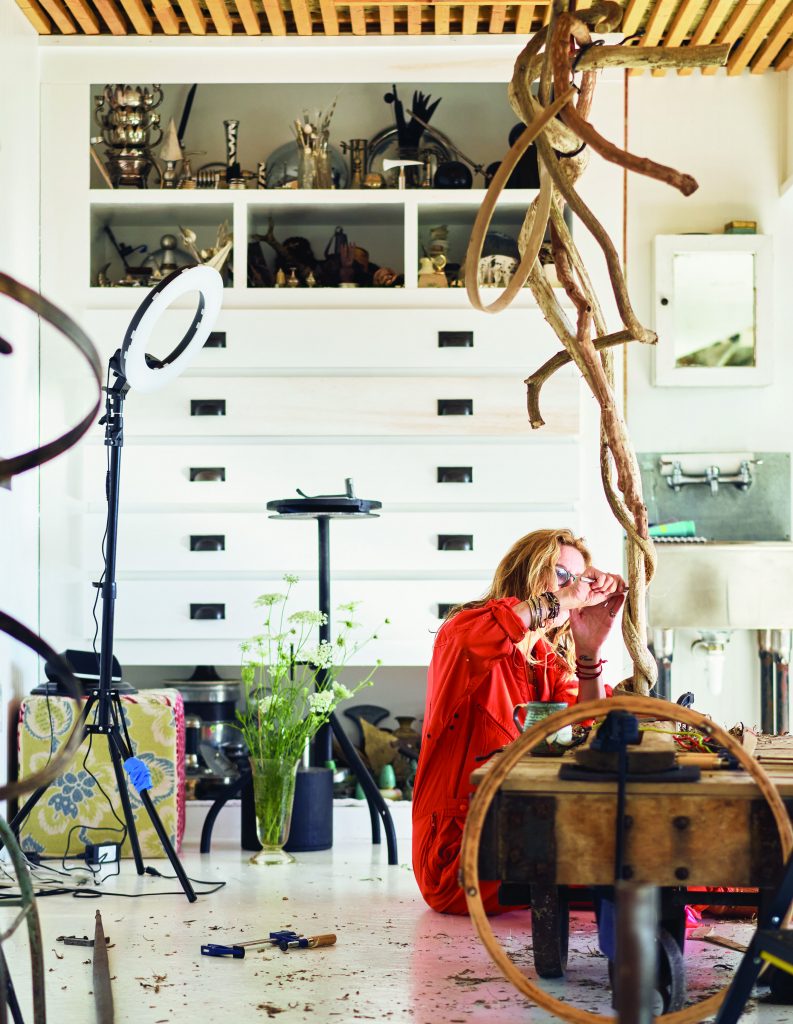 I’m not trying to replicate or retell these stories in my art so much as I am inviting others to make a deeper spiritual connection, one that comes as much from the heart as the bones and other objects. Certainly, the work culminates in the sculptures but they are actually the outcome of the collected journey. Everything in the work leads back to the process of archiving mythic collections and to how it all started—out in the woods, on beaches, and in our travels—and to where it leads now, which is back to the studio.
I’m not trying to replicate or retell these stories in my art so much as I am inviting others to make a deeper spiritual connection, one that comes as much from the heart as the bones and other objects. Certainly, the work culminates in the sculptures but they are actually the outcome of the collected journey. Everything in the work leads back to the process of archiving mythic collections and to how it all started—out in the woods, on beaches, and in our travels—and to where it leads now, which is back to the studio.
Studio work is ceaseless; every day the studio changes. Drawers open and close, objects appear and find their way into sculptures or back into the archives. The studio is not only the place where I work but an integral part of my creativity. It’s more than its well archived drawers, shelves, books, workbenches, and tools. It is a sanctuary, a sacred space.
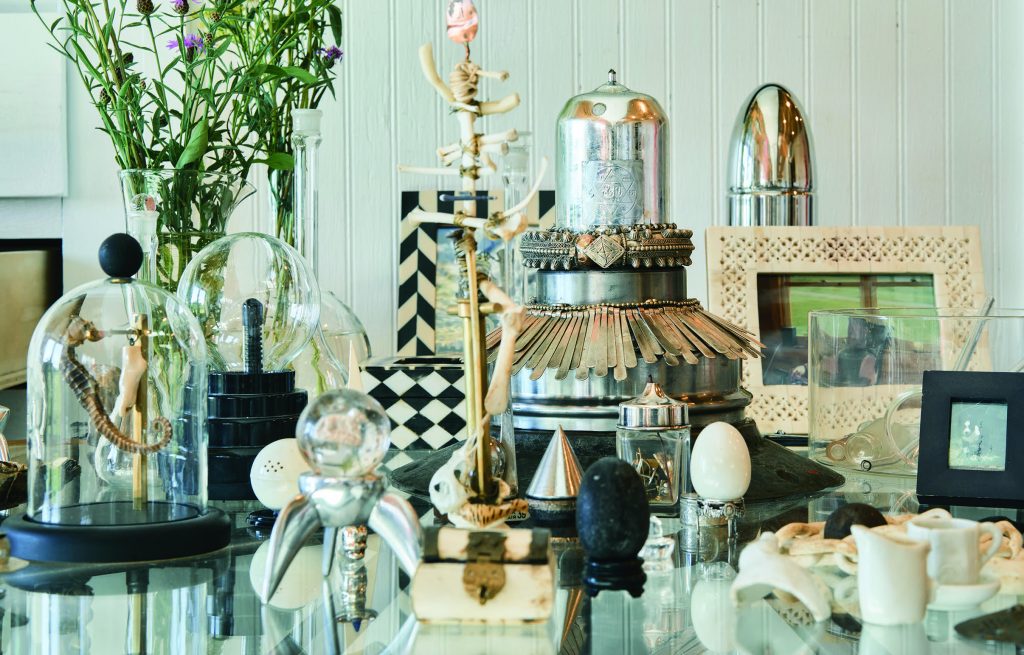 The studio space is both coherent and unsettling because it too is a work in progress, much like the concepts and cultures that are coming together in the sculptures. I am aiming for a kind of three-dimensional calligraphy that traces the paths of elements, bodies from the natural world, and the written word that assembles disparate parts into whole forms. Carl Jung described the deepest connection that people share as originating in the collective unconscious. I mean to collect the unconscious to create art that is both narrative and evocative. When we experience art that emerges from the unconscious, new possibilities for living life more richly arise.
The studio space is both coherent and unsettling because it too is a work in progress, much like the concepts and cultures that are coming together in the sculptures. I am aiming for a kind of three-dimensional calligraphy that traces the paths of elements, bodies from the natural world, and the written word that assembles disparate parts into whole forms. Carl Jung described the deepest connection that people share as originating in the collective unconscious. I mean to collect the unconscious to create art that is both narrative and evocative. When we experience art that emerges from the unconscious, new possibilities for living life more richly arise.
My studio has shown me how to assemble and disassemble myself. It is far more than an archive or an atelier. I need to create the way I need to breathe, to offer more stories and make more journeys. The studio extends into sense of myself and into the countless memories that reside in all the things it contains. When I share my studio, I invite you to come with me on those journeys of the soul.
About six years ago my husband and I started watching the series Vikings. In the show’s first few moments I saw something in the character Loki’s lair that changed the direction of my work. Hanging from a tree was a talisman made of driftwood or delicate animal bones. It reminded me of an ancient cairn and appeared to be quite important: it was telling a story or was part of the story being told. This was a defining moment for me, a true epiphany.
I realized at once the purpose of my obsessive collecting, that the multitude of archived objects I’d been squirreling away my entire life were an extension of myself. I choose them because they choose me.

I knew I would have to work with the possibilities and limitations that are part of our home environment but also that my collecting, organizing the droves of objects, accessing them and working in the studio were all vital aspects of the sculptures I was envisioning. My inventory has grown by matrices over the years and will continue to grow, but their place in an intuitively redesigned, reimagined studio would allow me to evolve and grow, all as parts of myself. I envision three-dimensional sculptures that are both evocative and narrative, that express my feelings directly and also tell the stories that have shaped my life’s experience and my imagination.
Like the organs in the body, I know where every new piece naturally and intuitively needs to go. My organic sensibility about my inventory became an important part of transforming a new studio. I needed to find a place for all like-minded things to live together.
 This awakening to make sculpture was all the more strange because I’d been principally a painter ever since I was a child. I graduated from the Philadelphia College of Art in 1980 with a BFA in Painting, and like many artists, I had to stop painting in order to support myself—working in restaurants, of course. I had landed a few rewarding jobs after college, including owning a yoga and Pilates studio in New Hope, PA. Years of studies in the mythology of the Hindu gods and goddesses had proven an essential element in teaching asana (yoga poses) and has deeply informed my three-dimensional work.
This awakening to make sculpture was all the more strange because I’d been principally a painter ever since I was a child. I graduated from the Philadelphia College of Art in 1980 with a BFA in Painting, and like many artists, I had to stop painting in order to support myself—working in restaurants, of course. I had landed a few rewarding jobs after college, including owning a yoga and Pilates studio in New Hope, PA. Years of studies in the mythology of the Hindu gods and goddesses had proven an essential element in teaching asana (yoga poses) and has deeply informed my three-dimensional work.
My family has deep personal connections to India that began even before meeting my husband, a professor of Hinduism and comparative religions. These stories have always been important to my evolution as an artist. We’ve since made numerous pilgrimages all across India, which has given me a much broader scope in understanding the pantheon of Hindu deities. I work in tandem with these images, symbols, and stories. All of my sculptures start with a narrative; there is always a thread of recognition I am pointing towards. My hope for the individual viewer is to formulate their own personal interpretation.
After the epiphany triggered by Vikings I also began to explore more seriously Norse and Celtic traditions. I became fascinated with representations of cosmology, such as helixes, DNA, and spirals, which led to studies in astronomy and physics and the sixteenth century’s mechanical representations (think: Galileo Galilei) inspired as much by religion as imagination. I began to see the gods and goddesses of all the pantheons anew. I was reimagining worlds of myth and science, and the feelings that emerged from these studies.
Also evolving was a deeper connection with my lifetime of exploring forests, deserts, creek beds, beaches, and ravines. I realized a pattern: objects, particularly antlers, bones, and fossils, seemed to find me. I could feel their presence, see the temperature of the color they emit. My first significant find was a lost child’s tea set in the snow and then, in that same forest in New Hope, PA, I saw the top of a skull and then bones, both unfamiliar to me, peeking out of the snow. It turned out to be a male black bear. Going back to the site many times over, I collected most of the bear’s bones and reassembled him on my dining room table. I began studying the anatomy of the forest animals in my area, identifying their tracks, feathers and fur, bones and scat. From that point forward, journeys anyplace meant that I would be bringing home countless objects, including things that humans had left behind or lost.
 When all of this excavation and collecting began 60 years ago, I hadn’t the slightest idea what I would do with all I was finding. I only knew that I had to keep doing it. I knew it was important for the journey to continue and that at some point I would discover why. The journey itself would reveal its purpose. Everything was connected—being a lifelong artist, a seeker, a finder of objects, a lover of myth and science.
When all of this excavation and collecting began 60 years ago, I hadn’t the slightest idea what I would do with all I was finding. I only knew that I had to keep doing it. I knew it was important for the journey to continue and that at some point I would discover why. The journey itself would reveal its purpose. Everything was connected—being a lifelong artist, a seeker, a finder of objects, a lover of myth and science.
We live on some 50 acres in the Finger Lakes region of western New York with (very) long winters, extreme, dramatic weather, which is often harsh and rarely just calm. There is a wildness here, a sense of being out of control, and yet life organizes itself and is always moving.
In our area I find many farmers’ dumps and the detritus of centuries past. As I enter these places I surrender to the possibilities of what might be in the earth waiting for liberation. Each time I go exploring I learn more about where treasures are likely to be and how to see them, but the process of looking and finding has always felt mutual. What I find finds me, on the outside and inside.
Because everything has a story, I was looking to tell my own.
In my studio things, too, can get wild; it may look chaotic or disorganized but then the pieces come together—even when the center cannot hold—and the objects form into the stories I want to tell. The sculptures tell those stories by being made of my entire journey of experiences. Their meaning is up to the viewers.
 I’m not trying to replicate or retell these stories in my art so much as I am inviting others to make a deeper spiritual connection, one that comes as much from the heart as the bones and other objects. Certainly, the work culminates in the sculptures but they are actually the outcome of the collected journey. Everything in the work leads back to the process of archiving mythic collections and to how it all started—out in the woods, on beaches, and in our travels—and to where it leads now, which is back to the studio.
I’m not trying to replicate or retell these stories in my art so much as I am inviting others to make a deeper spiritual connection, one that comes as much from the heart as the bones and other objects. Certainly, the work culminates in the sculptures but they are actually the outcome of the collected journey. Everything in the work leads back to the process of archiving mythic collections and to how it all started—out in the woods, on beaches, and in our travels—and to where it leads now, which is back to the studio.
Studio work is ceaseless; every day the studio changes. Drawers open and close, objects appear and find their way into sculptures or back into the archives. The studio is not only the place where I work but an integral part of my creativity. It’s more than its well archived drawers, shelves, books, workbenches, and tools. It is a sanctuary, a sacred space.
 The studio space is both coherent and unsettling because it too is a work in progress, much like the concepts and cultures that are coming together in the sculptures. I am aiming for a kind of three-dimensional calligraphy that traces the paths of elements, bodies from the natural world, and the written word that assembles disparate parts into whole forms. Carl Jung described the deepest connection that people share as originating in the collective unconscious. I mean to collect the unconscious to create art that is both narrative and evocative. When we experience art that emerges from the unconscious, new possibilities for living life more richly arise.
The studio space is both coherent and unsettling because it too is a work in progress, much like the concepts and cultures that are coming together in the sculptures. I am aiming for a kind of three-dimensional calligraphy that traces the paths of elements, bodies from the natural world, and the written word that assembles disparate parts into whole forms. Carl Jung described the deepest connection that people share as originating in the collective unconscious. I mean to collect the unconscious to create art that is both narrative and evocative. When we experience art that emerges from the unconscious, new possibilities for living life more richly arise.
My studio has shown me how to assemble and disassemble myself. It is far more than an archive or an atelier. I need to create the way I need to breathe, to offer more stories and make more journeys. The studio extends into sense of myself and into the countless memories that reside in all the things it contains. When I share my studio, I invite you to come with me on those journeys of the soul.

 This awakening to make sculpture was all the more strange because I’d been principally a painter ever since I was a child. I graduated from the Philadelphia College of Art in 1980 with a BFA in Painting, and like many artists, I had to stop painting in order to support myself—working in restaurants, of course. I had landed a few rewarding jobs after college, including owning a yoga and Pilates studio in New Hope, PA. Years of studies in the mythology of the Hindu gods and goddesses had proven an essential element in teaching asana (yoga poses) and has deeply informed my three-dimensional work.
This awakening to make sculpture was all the more strange because I’d been principally a painter ever since I was a child. I graduated from the Philadelphia College of Art in 1980 with a BFA in Painting, and like many artists, I had to stop painting in order to support myself—working in restaurants, of course. I had landed a few rewarding jobs after college, including owning a yoga and Pilates studio in New Hope, PA. Years of studies in the mythology of the Hindu gods and goddesses had proven an essential element in teaching asana (yoga poses) and has deeply informed my three-dimensional work. When all of this excavation and collecting began 60 years ago, I hadn’t the slightest idea what I would do with all I was finding. I only knew that I had to keep doing it. I knew it was important for the journey to continue and that at some point I would discover why. The journey itself would reveal its purpose. Everything was connected—being a lifelong artist, a seeker, a finder of objects, a lover of myth and science.
When all of this excavation and collecting began 60 years ago, I hadn’t the slightest idea what I would do with all I was finding. I only knew that I had to keep doing it. I knew it was important for the journey to continue and that at some point I would discover why. The journey itself would reveal its purpose. Everything was connected—being a lifelong artist, a seeker, a finder of objects, a lover of myth and science. I’m not trying to replicate or retell these stories in my art so much as I am inviting others to make a deeper spiritual connection, one that comes as much from the heart as the bones and other objects. Certainly, the work culminates in the sculptures but they are actually the outcome of the collected journey. Everything in the work leads back to the process of archiving mythic collections and to how it all started—out in the woods, on beaches, and in our travels—and to where it leads now, which is back to the studio.
I’m not trying to replicate or retell these stories in my art so much as I am inviting others to make a deeper spiritual connection, one that comes as much from the heart as the bones and other objects. Certainly, the work culminates in the sculptures but they are actually the outcome of the collected journey. Everything in the work leads back to the process of archiving mythic collections and to how it all started—out in the woods, on beaches, and in our travels—and to where it leads now, which is back to the studio. The studio space is both coherent and unsettling because it too is a work in progress, much like the concepts and cultures that are coming together in the sculptures. I am aiming for a kind of three-dimensional calligraphy that traces the paths of elements, bodies from the natural world, and the written word that assembles disparate parts into whole forms. Carl Jung described the deepest connection that people share as originating in the collective unconscious. I mean to collect the unconscious to create art that is both narrative and evocative. When we experience art that emerges from the unconscious, new possibilities for living life more richly arise.
The studio space is both coherent and unsettling because it too is a work in progress, much like the concepts and cultures that are coming together in the sculptures. I am aiming for a kind of three-dimensional calligraphy that traces the paths of elements, bodies from the natural world, and the written word that assembles disparate parts into whole forms. Carl Jung described the deepest connection that people share as originating in the collective unconscious. I mean to collect the unconscious to create art that is both narrative and evocative. When we experience art that emerges from the unconscious, new possibilities for living life more richly arise.
